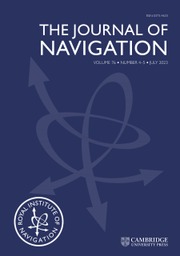No CrossRef data available.
Article contents
The Significance of Marshallese Stick Charts
Published online by Cambridge University Press: 18 January 2010
Abstract
The stick charts found in the Marshall Islands, of which some 20 or 30 are extant in museums throughout the world, have for long puzzled historians of navigation. In this paper, which is based on a more complete work, to be published elsewhere, the author examines the authenticity and meaning of these objects and concludes that they were mnemonic devices, of no great antiquity, to facilitate navigation and to train navigators.
- Type
- Research Article
- Information
- Copyright
- Copyright © The Royal Institute of Navigation 1967
References
Brandt, John H. (1963). ‘By Dunung and Bouj’, Natural History, 72 (2) February 1963, 26–29.Google Scholar
de Brum, Anton III., (1966). Author's notes on conversations with Mr. de Brum at University of Hawaii, May, June.Google Scholar
de Laubenfels, M. W. (1950). ‘Native Navigators’, Research Reviews, Office of Naval Research, June 7–12.Google Scholar
Golson, Jack. (1963). Polynesian Navigation, The Polynesian Society, Inc., Avery Press, Ltd., New Plymouth, New Zealand.Google Scholar
Lokrap, and Cunningham, . (1950). ‘Marshallese Navigation’, as told to Eve Gray, Sunday Magazine Feature, Honolulu Advertiser, 19 March 1950.Google Scholar
Milne, James. (1953). ‘Meto Marshallese Navigation’, Hawaiian Academy of Science Proceedings, 28th Annual Meeting.Google Scholar
Sailing Directions for the Pacific Islands. Vol. I. U.S. Hydrographic Office, Publication No. 82.Google Scholar
Sharp, Andrew. (1956) Ancient Voyagers in the Pacific, Polynesian Society, Wellington, New Zealand.Google Scholar
Winkler, Captain (1901). Sea charts normally used in the Marshall Islands, Smithsonian Institution Annual Report for 1899, Washington, D.C.Google Scholar


